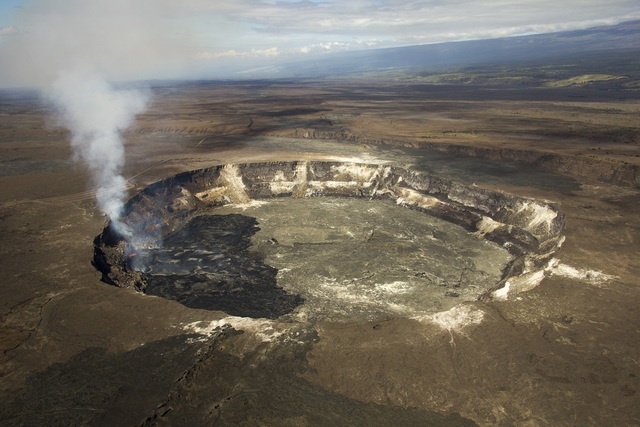In response to increased seismic activity along the East Rift Zone, Hawaii Volcanoes National Park closed backcountry trails and campgrounds below Kilauea’s summit for overnight use.
Spokeswoman Jessica Ferracane said the current situation — increased seismicity and a drop in the summit lava lake level — is reminiscent of what occurred in 2011 with the Kamoamoa eruption.
“This is really a safety and precautionary method right now that we’re employing,” she said of the closure, adding the hope is to avoid a situation in which backcountry users are cut off by a potential fissure eruption.
Steve Brantley, deputy scientist-in-charge at Hawaiian Volcano Observatory, said that when the summit began to inflate late last month, the frequency in earthquakes also picked up. And during the weekend, he said, there were a couple of “very energetic clusters” of earthquakes.
The combination of inflation and increased seismicity suggests magma is accumulating in the summit reservoir, according to Brantley.
“The conditions are, in a sense, right for magma moving out of the summit reservoir and into one of the rift zones, but it’s not a guarantee that that scenario will play out,” he said.
It a written statement Monday, the park said that when the 2011 eruption occurred, it was not able to tell where lava would emerge, and a similar eruption could impact safe visitation anywhere along the East Rift Zone.
“Although there is no immediate indication that this scenario is happening, we are making these closures just in case,” park officials said.
Ferracane said the closures impact Kulanaokuaiki Campground, Napau Campground and the coastal camping areas. All backcountry trails remain open for daytime use.
The park said it will reevaluate the situation as information is made available by HVO.
“The safety of visitors and employees is our highest priority,” Ferracane said in an email. “Once seismic activity returns to its normal levels and stabilizes, the park will re-evaluate and reopen these trails and campgrounds to overnight use as appropriate.”
The closure comes in the midst of a deflationary event at Kilauea’s summit. During the weekend, the lava lake surface dropped to about 10 meters (33 feet) below the Overlook crater rim and 2 to 3 meters below the original floor of Halema‘uma‘u Crater, according to HVO.
“It looks like it’s still dropping,” Brantley said Monday afternoon, although he did not have an updated measurement.
On Saturday, a 4.5-magnitude earthquake rattled the Ka‘u area. It struck at about 2:18 a.m. and was centered about 5 miles north of Naalehu at a depth of 6 miles, according to HVO. The earthquake caused no detectable changes in Kilauea volcano’s ongoing eruptions, on Mauna Loa, or at other active volcanoes. A magnitude 3.1 earthquake that occurred in Kilauea Caldera about one minute before the magnitude 4.5 earthquake was unrelated to the Naalehu event.
On Monday afternoon, a 3.1-magnitude quake occurred 2.3 miles south-southwest of Kilauea’s summit, at a depth of 1.6 miles.
For updated information, visit hvo.wr.usgs.gov.
Email Chris D’Angelo at cdangelo@hawaiitribune-herald.com.






